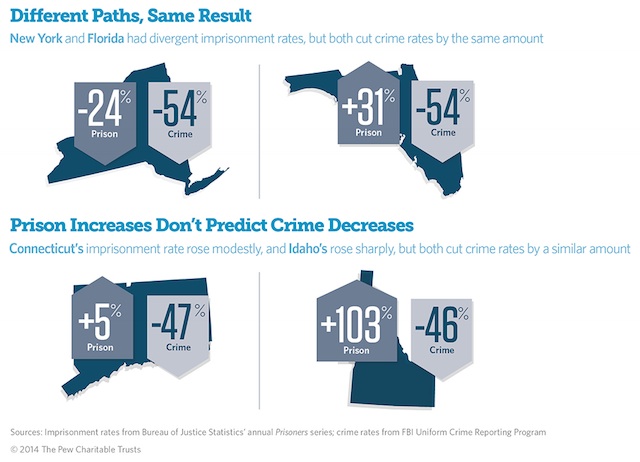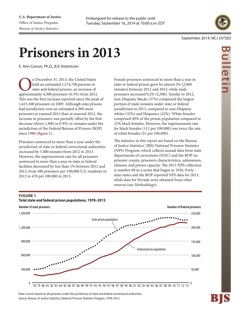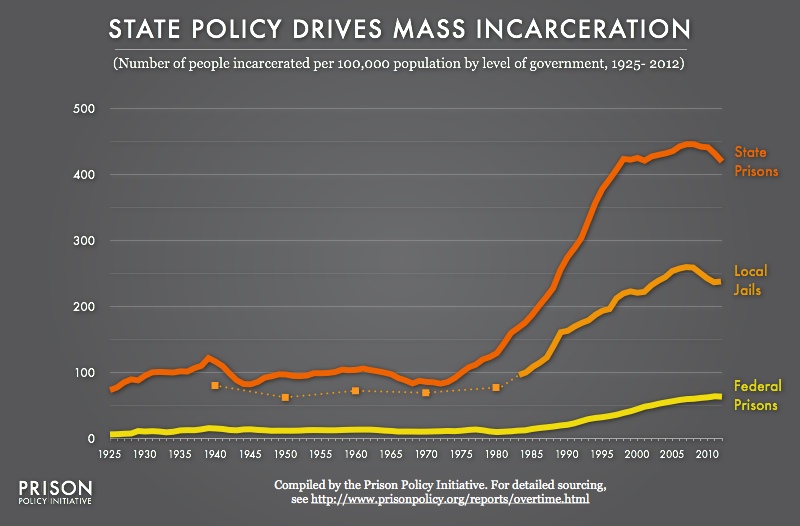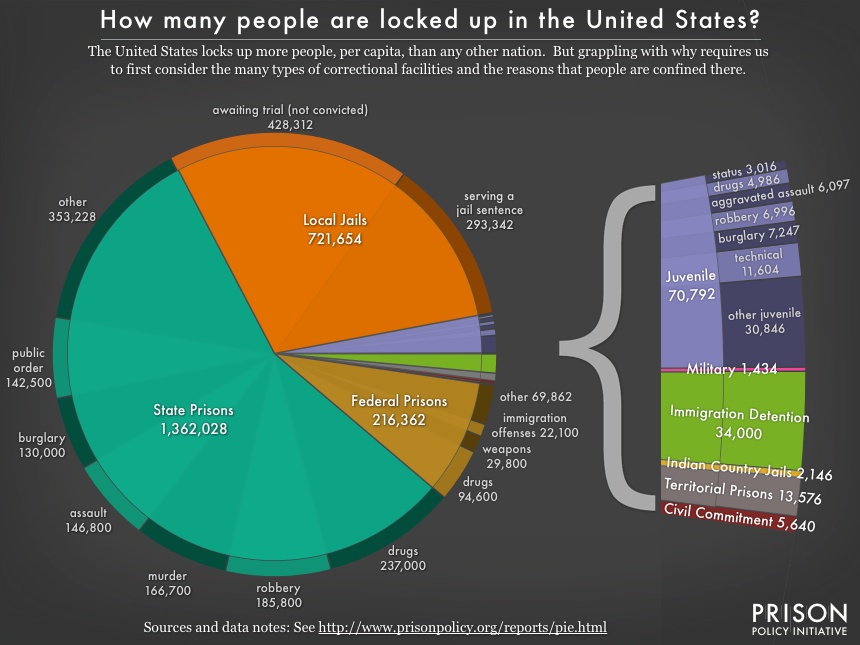Governor Brown signs California prison anti-sterilization bill into law.
by Bernadette Rabuy,
September 26, 2014
Yesterday, Governor Jerry Brown signed SB 1135 (Senator Hannah-Beth Jackson), putting an end to sterilization abuse in California prisons. This is a well-earned victory for our friends at Justice Now, whose hard work allowed the bill to pass unanimously out of both the Senate and Assembly.
“This bill not only affects those still inside prisons and the thousands of women who will go through prisons and jails in the near future; but most importantly it protects generations of children to come who otherwise might not have had an opportunity to exist” says Kelli Dillon who was sterilized in her early 20’s while incarcerated at Central California Women’s Facility in Chowchilla. Kelli, however, goes on to say “we still need an apology and acknowledgement of what was done to us.” While this bill comes a long way in addressing the abusive and coercive conditions under which sterilizations were happening it is a reminder that work still needs to be done to properly address those who had their ability to have children so callously and egregiously taken away.
We are glad that Governor Brown has taken a step toward reversing California’s shameful legacy of eugenics, and we are hopeful that this bill will support California prisons in more effectively protecting the human rights of the incarcerated.
"The wheels of justice turn slowly, but today we prepare to take the next critical step toward reducing the high price paid by inmates and their families to communicate"
by Aleks Kajstura,
September 26, 2014
Yesterday, Chairman Wheeler and Commissioner Clyburn issued the following joint statement regarding the circulation to their fellow commissioners of proposals for further reform of the inmate calling regime:
The wheels of justice turn slowly, but today we prepare to take the next critical step toward reducing the high price paid by inmates and their families to communicate.
Our recent reforms have reduced interstate long-distance inmate calling rates by nearly 40%, and that is a very positive development. But many families of inmates still face exorbitant rates for in-state calls, not to mention punitive and irrational fees—all of which make the simple act of staying in touch unaffordable.
The Further Notice of Proposed Rulemaking we are circulating today proposes a simple, market-based solution to address all these problems. It proposes rules that will ensure that ALL Americans – including inmates and their families – have access to phone service at rates that are just, reasonable and fair. We look forward to working with our colleagues to adopt permanent reform as soon as possible.
Two commissioners circulate a proposal that would extend last year's historic ruling protecting some families from the predatory prison and jail telephone industry.
by Peter Wagner,
September 25, 2014
Federal Communications Commissioner Clyburn and Chairman Wheeler are circulating to their colleagues a new proposal to regulate the prison and jail telephone industry.
There aren’t a lot of details in the Commission’s press release, but it appears the Commissioners want extend their earlier progress to:
- Extend the regulation and price caps on interstate calls to the vast majority of calls home from prisons and jails that are to numbers within the same state.
- Further restrict the industry’s payments that can be made to the facilities as these payments drive up the cost of a call.
- Fully address the ancillary charges for opening, having, funding and closing accounts. Beyond the actual costs of the call, ancillary charges consume an estimated 400 million dollars per year.
The draft isn’t available yet, but when it is, we’ll have a full analysis and be working with our friends to encourage public comment on it. For background, see our phones page.
Martha Wright and her fellow petitioners mine prison phone companies' state-mandated disclosures to submit rate data to the FCC when the companies refuse answer the basic questions themselves.
by Aleks Kajstura,
September 23, 2014
The Federal Communications Commission (FCC) has been seeking information on the interstate rates charged by the prison phone companies, but the companies have been stalling. Now the FCC is considering regulation of intrastate rates as well. Martha Wright and her fellow petitioners don’t expect the companies to cooperate here either, so the petitioners took the task up themselves and submitted the companies’ publicly disclosed rates to the FCC:
While the provided information is not exhaustive, it does illustrate the widely-divergent rates for the three classes of Intrastate ICS calls. The wide range of rates cannot be explained solely by looking at whether a call is local, IntraLATA, or InterLATA. Moreover, since most every ICS call is routed to calling centers outside the originating state, the artificial differences in rates among Local, IntraLATA and InterLATA calls are simply unnecessary. While ICS providers have previously attempted to divert the FCC’s attention from reviewing their tariffed rates, in light of the ICS providers’ past refusal to provide this information, and the fact that these providers went to the extreme measure of obtaining a court order staying the effectiveness of [the FCC’s request for information published in] 47 C.F.R. §64.6060 so that they would not have to provide this information, the ICS providers cannot now argue that the FCC should merely ignore the publically-available information.
The full filing with the attached rates is available in 7 parts on the FCC’s website — take a look at the companies’ disclosures yourself:
Rachel Bloom, Director of Membership and Special Projects, Funders' Committee for Civic Participation , shares her thoughts on her work and why she joined PPI's board.
by Peter Wagner,
September 22, 2014
Next up in our blog series introducing several accomplished new members of the Prison Policy Initiative board: Rachel Bloom. Rachel is Director of Membership and Special Projects at the Funders’ Committee for Civic Participation. We are so glad to have her on our team here at PPI.

Why did you decide to join the PPI board?
Rachel Bloom: I have long been an admirer (and colleague of PPI) and have worked with them over the years. I was working on state criminal justice reform for several years at the national office of the ACLU. As I transitioned to a new job I wanted to continue to work on criminal justice reform. Joining the PPI board seemed like the perfect step.
What does your work focus on? And what’s the connection between that work and PPI?
RB: I work at the Funders’ Committee for Civic Participation, a philanthropic network for foundations that support civic engagement work. Two of the issues I focus on supporting our membership with are the census and redistricting. I find it fitting that the issues that first introduced me to PPI — felony disfranchisement and prison gerrymandering — are still ones that I work on now 8 years later.
What do you think is most unique about the Prison Policy Initiative and the projects it takes on?
RB: I think that PPI has taken on some very distinct projects that no one else was willing to step up to the plate on. I am so proud of PPI for working on such important issues and moving the needle forward on them.
What’s something that you wish more people knew about the Prison Policy Initiative?
RB: I wish that people understood just how broad of a reach PPI has, how many issues we work on and how impactful we are – especially considering the size of our staff and budget. I was first introduced to PPI while working on felony disfranchisement and prison gerrymandering and thought that was the sum total of PPI, little did I know how wrong I was.
In March, we were honored to be one of the three charities chosen by CharitySub as one of three organizations addressing the prison epidemic. We report back.
by Peter Wagner,
September 19, 2014

In March, we were honored to be one of the three charities chosen by CharitySub as one of three organizations addressing the prison epidemic.
CharitySub is an innovative new approach to online giving. CharitySub members pledge $5 a month, and each month CharitySub picks a new cause and identifies three non-profits making a difference on that cause. Each month, CharitySub members get to pick which of the three organizations receives their $5. Most recently, Charity Sub members have supported organizations addressing STEM education, wildlife welfare, beach conservation, drug free youth, and — this month’s topic — body image.
You can join today to support this month’s organizations and learn about other organizations doing great work in the future.
Thank you, Charity Sub members, for supporting our work. With your help, we won a big victory two weeks ago, convincing Dallas County Texas to reject a video visitation contract that was going to replace the usual visiting hours for families with expensive video visitation. This is the first time the public was able to stop one of these anti-family contracts, so we expect it will have a national effect. Thank you for making this victory for families possible.
While recent BJS figures showed an increase in total incarcerated population, crime figures show a decrease in violent crime.
by Bernadette Rabuy,
September 18, 2014
 This morning, two days after releasing, Prisoners in 2013 the Bureau of Justice Statistics released, Criminal Victimization, 2013. Once again, the BJS released criminal justice figures that reverse the trend of the past few years. After two years of slight increases in the nation’s violent crime rate, the violent crime rate declined slightly from 26.1 victimizations per 1,000 persons in 2012 to 23.2 per 1,000 in 2013. (The crime rate is now re-approaching the record low it hit in 2010 and is far lower than it was two decades ago.)
This morning, two days after releasing, Prisoners in 2013 the Bureau of Justice Statistics released, Criminal Victimization, 2013. Once again, the BJS released criminal justice figures that reverse the trend of the past few years. After two years of slight increases in the nation’s violent crime rate, the violent crime rate declined slightly from 26.1 victimizations per 1,000 persons in 2012 to 23.2 per 1,000 in 2013. (The crime rate is now re-approaching the record low it hit in 2010 and is far lower than it was two decades ago.)
While there were no statistically significant changes in most other types of crime, the slight drop in the crime rate was mostly the result of a decline in simple assault, which is violence that doesn’t include a weapon or serious injury. The decline in simple assault accounted for about 80% of the change in total violence. The rate of property crime also fell from 155.8 victimizations per 1,000 households in 2012 to 131.4 per 1,000 in 2013.
These figures led to an interesting discussion on Twitter among those of us who have been closely following BJS’ recent releases. In BJS’ Prisoners in 2013, we learned that the state and federal prison population increased slightly from 2012 to 2013, the first overall increase since 2009. Although these figures may point out that it is too early to be celebrating the end of mass incarceration, it is safe to say that the state and federal prison population has held fairly steady compared to the rapid rise of earlier decades.
As Mariame Kaba of Project NIA tweeted, it is extremely difficult to draw a relationship between the imprisonment rate and the crime rate. In Ted Gest’s analysis of Criminal Victimization, 2013, he wrote for The Crime Report,
Critics question why more people should be behind bars while crime is dropping. The basic answer is that there is not necessarily a connection between the two sets of numbers.
The Pew Public Safety Performance Project recently released a data visualization trying to illustrate the complex link between prison and crime. While the BJS’ releases looked at the change in incarceration and crime over the last year, the Pew Public Safety Performance Project recently analyzed state incarceration and crime rates from over the last two decades. They found that the five states with the largest decreases in their imprisonment rates were able to reduce their crime rates. Overall, there isn’t a clear-cut trend, but one thing is clear: locking more people up doesn’t necessarily lead to less crime.

The visualization is a reminder of what we found in our report, Tracking State Prison Growth in 50 States: State policy drives mass incarceration. States with high rates of incarceration have very little to show for it.
Our briefing on the new Bureau of Justice Statistics numbers spark discussion on Twitter.
by Catherine Cain,
September 18, 2014
On Tuesday, the Prison Policy Initiative released a briefing on the Bureau of Justice Statistics’ national update for 2013, Prisoners in 2013. PPI’s briefing highlighted continuing racial disparities within the prison system and record high prison populations in 14 U.S. states. It also showed that, after three years of decline, the total prison population has increased and disproved any relationship between state crime rates and incarceration rates. After posting some of these highlights on Twitter, we received a variety of excited responses and more twitter traffic than we’ve seen since June.
Here is what a few users had to say:
Liam Johnston succintly tweets:
PPI supporter and board member Heather Ann Thompson:
The Southern Poverty Law Center called our briefing a must read.
Organizer with Milk Not Jails, Brenden Beck, also noted:
A lot of people pulled out their favorite findings from our briefing, including the racial disparity facts:
After learning that 14 individual U.S. states set record high prison populations this past year, many twitter followers also commented on how these individual states– as well as the U.S. as a whole –measure in comparison to other countries. Some commentators revisited statistics that the Prison Policy Initiative published last year, States of Incarceration: The Global Context:
Orleans Public Defender tweets:
Feel left out on all the action? Follow us on Twitter.
Sesame Street's series on incarceration, with videos, activities, and tips for parents, providers, and caregivers
by Bernadette Rabuy,
September 18, 2014
A couple of months ago, John Oliver did a hilarious episode on prisons including a scene in which Oliver sings about prisons with Sesame Street muppets. A few days ago, thanks to a tweet by the Southern Coalition for Social Justice, we got to see another, animated video from the Sesame Street series, “Little Children, Big Challenges: Incarceration.”
It’s a heartbreaking video and also an opportunity to get a glimpse into the life of a child with an incarcerated parent. Along with a series of videos with muppets and real kids’ stories, the Sesame Street toolkit includes activities and tips for incarcerated parents, providers, and caregivers. We agree with John Oliver that it’s great to see Sesame Street addressing mass incarceration, but it’s beyond disturbing that our nation’s failed policies and practices leave more than 2.7 million children with an incarcerated parent.
New report serves as a sobering reminder that state-level criminal justice policy decisions are continuing to ensure that our nation remains the top incarcerator in the world.
by Peter Wagner and Leah Sakala,
September 16, 2014
 This morning, the criminal justice policy world got a new key metric on mass incarceration in the U.S.: the Bureau of Justice Statistics’ national update, Prisoners in 2013. This report serves as a sobering reminder that state-level criminal justice policy decisions are continuing to ensure that our nation remains the top incarcerator in the world. While the report indicates a few promising improvements, the overall picture is grim.
This morning, the criminal justice policy world got a new key metric on mass incarceration in the U.S.: the Bureau of Justice Statistics’ national update, Prisoners in 2013. This report serves as a sobering reminder that state-level criminal justice policy decisions are continuing to ensure that our nation remains the top incarcerator in the world. While the report indicates a few promising improvements, the overall picture is grim.
Key takeaways from the report:
- Overall, the state and federal prison population increased slightly between 2012 and 2013. Although this is the first overall increase since 2009, the overall prison population has held fairly steady compared to the rapid rise of earlier decades.
- The number of people incarcerated in California increased. In the past several years, in response to a Supreme Court mandate, California’s prison population declined enough to pull the national incarceration rate down.
- While the total number of people incarcerated grew, the country as a whole grew faster, so there was a slight decline of less than half of a percent in the incarceration rate. This change is far too small to impact the results of our June report States of Incarceration: The Global Context finding that every state in this country uses incarceration far more than most of the world.
Here’s the good news:
- For the first time, the federal prison population reported a decline. Over the last decade, the federal Bureau of Prisons had been reporting a growth rate more than 4 times faster than the states, so this is a significant change in direction.
- Some states continue consistent declines in their prison population: New York and New Jersey have declined populations every year but one since 1999, Hawaii has declined for eight years in a row, and South Carolina 4 years in a row.
- 21 states reported declines in their sentenced prison population
- 10 states that had reported growing prison populations for both 2011 and 2012 reported a decline in 2013.
 Ending the U.S. experiment with mass incarceration requires us to focus on state policy because individual states are the most active incarcerating bodies in the nation. Graph from our May 2014 report, Tracking State Prison Growth in 50 States shows the number of people (per 100,000 national population at that time) that is confined in state, local and federal correctional facilities from 1925 to the present. State prisons are the largest part. (See larger or as raw numbers.)
Ending the U.S. experiment with mass incarceration requires us to focus on state policy because individual states are the most active incarcerating bodies in the nation. Graph from our May 2014 report, Tracking State Prison Growth in 50 States shows the number of people (per 100,000 national population at that time) that is confined in state, local and federal correctional facilities from 1925 to the present. State prisons are the largest part. (See larger or as raw numbers.)
And the bad news:
- Reversing 3 years of declining populations, the total prison population increased.
- The number of admissions to prison increased and the number of releases fell in 2013. Each are a bad sign and the combination of both is particularly harmful.
- Racial disparities continue to constitute the defining characteristic of the prison system. For example, 3% of Black males of all ages are currently incarcerated in state or federal prisons. This is a rate 6 times higher than white males.
- 14 states hit new record high prison populations in 2013: Arizona, Arkansas, Indiana, Kansas, Minnesota, Missouri, Nebraska, North Dakota, Ohio, Oklahoma, Oregon, Tennessee, Utah, and Wyoming.
- Texas, one of the states with the highest incarceration rates and which had a much heralded “reform” of its prison population, saw an increase in both its total prison population, its sentenced population, and its incarceration rate.
And remember, this new report from the Bureau of Justice Statistics is just talking about the state and federal prison population, which form just a portion of the much larger incarceration pie of which jails are the next largest piece:
 Lets not forget that people incarcerated in prison are just a portion of the people under control of the correctional system. There are jails, juvenile prisons, military prisons, immigration detention, Indian Country jails, territorial prisons, civil commitment, plus probation and parole of which there are 3,981,090 adults on probation, and 851,662 adults on parole.
Lets not forget that people incarcerated in prison are just a portion of the people under control of the correctional system. There are jails, juvenile prisons, military prisons, immigration detention, Indian Country jails, territorial prisons, civil commitment, plus probation and parole of which there are 3,981,090 adults on probation, and 851,662 adults on parole.
For more information about ending mass incarceration in your state, see our state profiles.


 This morning, two days after releasing,
This morning, two days after releasing, 






